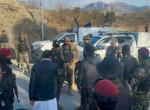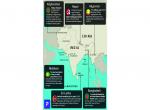According to some observers, “The significance of the Gilgit-Baltistan region of Pakistan-occupied Kashmir (PoK) in terms of geo-strategy only seems to be rising given the fluidity of strategic equations in South Asia”.1 The Chinese ‘strategic patience’, Indian ‘reticence’, Pakistani ‘opportunism’, political ‘activism’ of the indigenous people of the area and economic ‘imperatives’ abetted by ‘relative decline and dysfunctional politics’ of the ‘super powers of yesteryears’ define the current geo-political scenario in the area. A strategic design is unfolding that has great implications for the region and indeed the world.
Situated between the mountain ranges of Hindu Kush, Karakoram and Western Himalayas, Gilgit-Baltistan lies at the confluence of Central Asia, China and South Asia. It borders Wakhan Corridor of Afghanistan; Xinjiang Province of China, Pakistan's Khyber Pakhtunkhwa Province, Pakistan occupied Kashmir and Indian State of Jammu and Kashmir. Its geography offers the advantage of being the vital hub for trans-region exchanges. Predictably, Pakistan and China, have exploited the importance of this region to further their geo-strategic and economic objectives while India has watched from the side-lines assessing the magnitude and impact.
The 1949 ceasefire line resulted in the division of J&K with Pakistan gaining control over approximately 85,793 sq km of area. The government of Pakistan illegally ceded a large part of territory of the Shaksgam Valley measuring 5,180 sq km to China in 1963. Pakistan administered region of J&K was subsequently divided in 1970 into two administrative zones: Azad Jammu and Kashmir (AJK) and Federally Administered Northern Regions.
Covering a total area of 74,600 sq km, the Gilgit-Baltistan Region is administratively divided in two divisions of Gilgit and Baltistan. The Gilgit Division is divided into five districts, namely, Gilgit, Ghizer, Diamer, Astore, and Hunza Nagar; and the Baltistan Division has two districts of Skardu and Ghanchi under its administrative control.
Gilgit-Baltistan is home to more than one million people who belong to Balti, Shin, Burushu, Khowar and Wakhi ethnicity. They consider themselves different from predominant Pakistani groups and share strong cultural links with the Tibetans, Kashmiris, Tajiks, Uighurs and Mongols. Ethnically and linguistically, the people of Baltistan are related to the Ladakhis while the people of Gilgit, Chitral and Kashmir are Dardic, who speak related languages.
Gilgit-Baltistan is a resource rich region where uranium, copper, gems and gold are found in abundance; and glaciated water bodies cover a catchment area equal to the size of South Carolina. 2
The long-standing and continuing political alienation of Gilgit-Baltistan has been the prime cause for discontent among the local populace of Northern Areas. In a bid to resolve the politico-constitutional gridlock, Pakistan's federal government unanimously approved and passed the Gilgit-Baltistan Empowerment and Self-Governance Ordinance in 2009 as a replacement of the Northern Areas’ Legal Framework Order 1994. It was a façade to grant autonomy to the Northern Areas through a Presidential decree. The move has under-addressed the anxiety of the people of the Northern Areas. The move will impact Pakistan’s stand on the wider Jammu and Kashmir dispute with India. Pakistan has always emphasized on ‘resolving the J&K dispute according to the wishes of the people of J&K’, making unilateral transformation of the politico-legal status of the Northern Areas amounts to implicit change in oft proclaimed stand. Complete silence on the part of the international community and India on the issue gives the impression that the LOC has been accepted as fait accompli and Pakistan sovereign right over Azad Kashmir and Northern Areas is implicitly accepted.3
This development acted as a precursor to much increase in on-going Chinese involvement in Gilgit-Baltistan. The Chinese investments and involvement in infrastructure development project have seen a steady increase over the last few years. It is interesting that both the countries have remained evasive and non-committal while explaining ever-increasing Chinese presence in GB and POK. It is believed in some quarters that Chinese are following an aggressive expansionist approach to step forward and secure their interests of protecting vulnerable Muslim minorities against ‘Jihadi’ influence, promoting economic interests and jockeying to be the major power in the region.
Viewed from the stand point of Pakistan in the strategic context, both Kashmir and Afghanistan remain the pieces of the same puzzle. The Chinese recent forays both in Afghanistan and Gilgit-Baltistan may be explained as endeavours to fill in the vacuum likely to be caused by the projected US-NATO withdrawal, to seek a broad spectrum protection from the consequences of a beleaguered Pakistan and to challenge India’s influence in the region.
Investing billions of dollars in various infrastructure and other projects in the Gilgit-Baltistan region of PoK involving several thousand Chinese personnel belonging the People's Liberation Army (PLA) have caused much suspicion and uneasiness both among the indigenous people and the strategic community. There have been reports of protests and clashes in Hunza and other places between locals protesting against the ‘stealing of jobs’ by the Chinese. 4
China's Western Highway, also known as the Lhasa-Kashgar Highway connects Xinjiang to Tibet. From Quilanaldi, the road branches off to the Khunjerab Pass and, subsequently, becomes the Karakoram Highway right up to Gilgit. The 1,300 km long Karakoram Highway remains the only all-weather road linking Gilgit-Baltistan with the rest of Pakistan. Upgrading the Karakoram Highway is of critical significance to China, since this region offers Beijing a window to the Arabian Sea and the Indian Ocean.
It has been reported that as per a Memorandum of Understanding (MoU) signed in June 2006 between China and Pakistan, the Karakoram Highway is being widened from 10 metres to 30 metres — resulting in its operational capacity going up threefold catering for heavy vehicular movement. In July 2010, during the visit of Pakistan's President Zardari to China, MoUs with China were signed for Karakoram Highway Project Phase-2 that includes widening the Jaglot-Skardu road to be completed by end of 2012.
The infrastructure investment announced by Beijing includes construction of a railway link with Pakistan. The proposed railroad will connect the town of Havelian in Abbottabad district in Pakistan's Khyber Pakhtunkhwa to the Khunjerab Pass. Chinese are thus involved in a huge infrastructure development exercise in Gilgit-Baltistan and PPOK involving construction of expressway, tunnels, railways, several dams, telecommunication facilities, industrial zones in Gilgit and Muzaffarabad, bridges, developing mines etc. China possibly shares the responsibility with Pakistan to manage the telecommunication system of GB. So by implication the Chinese control over the telecommunication and transportation network in an indirect manner may be complete already. 4
With the reported considerable presence of PLA in POK and Gilgit-Baltistan, the garb of undertaking developmental activities and protection duties, has serious implications for India. Not only the capability of Pakistan Army to create mischief in J &K stands considerably enhanced, in case of a crisis or a conflict situation, it allows the Chinese to exploit the Western flank in conjunction with its military operations from East against Ladakh and J&K.
From the strategic perspective, the Chinese "development projects" in Gilgit-Baltistan are a reflection of pursuance of an aggressive engagement of the Afghanistan, Pakistan, PoK and Gilgit-Baltistan region to alter the geo-strategic equations and to expand her sphere of influence in South Asia and Afghanistan. This should be seen as a part of a design to marginalise India taking advantage of her focus on internal consolidation and growth as well as hesitation to step out and assume a leadership role in the strategic milieu.
A major consequence of China extending its reach into Gilgit-Baltistan and POK is that the J &K dispute has become more complex which is likely to complicate any potential long-term resolution of Jammu and Kashmir.
According to Mumtaz Khan, director for the International Centre of Peace and Democracy in Toronto, “Many Western analysts who view China's stance merely as a bargaining chip against India will unfortunately soon realize that China is redefining its priorities and interests in South Asia and beyond. The current involvement of China in Gilgit-Baltistan and Pakistan administered Kashmir consists of more than just providing military and diplomatic support to Pakistan. Soon, Pakistan will swap its role to take the backseat as China exerts itself as a major player in the Kashmir issue.” 5
While addressing a Seminar held in House of Commons, Dr Shabir Choudhry said, “It is unfortunate that this time government of Pakistan is very keen to provide helping hand to the Chinese to have a foothold in this region; which could be extremely disastrous to Gilgit Baltistan and South Asia. Pakistani government is playing this dangerous game, as they face instability and a bleak future. Pakistani government wants to ensure that if they go down, then these areas are taken over by China, and India or another power doesn’t step in.” 6
Chinese expansionist moves to ‘economically engage the periphery’ and guard her core interest need to be viewed by India as attempts to reduce her influence in the neighbourhood. Indian polity needs to take matured and measured steps to secure her future ambitions. While taking appropriate steps to protect herself, India needs to ensure that the boundary question with China does not get enlarged and attempts at making her become a party to the Kashmir dispute is not allowed. The good will and the advantage of being ‘a step away’ India enjoys in Afghanistan, Gilgit-Baltistan, Central and South East Asia should be leveraged to counter any attempts to limit her to the sub-continent.
References
- Monika Chansoria in Guardian http://www.sunday-guardian.com/analysis/gilgit-baltistan
- Testimony of Senge Sering, Institute for Gilgit Baltistan Studies (IGBS) before the ‘Tom Lantos Human Rights Commission’, United States Congress July 26, 2011
- Gilgit-Baltistan Empowerment Ordinance: A Change in Nomenclature Only by Madhavi in the Trajectory. http://thetrajectory.com/blogs
- Senge Hasnan Sering, the director of the Gilgit Baltistan National Congress In an interview to Ramananda Sengupta. http://www.sify.com/news/Pakistan-China-must-leave-Gilgit-Baltistan-imagegallery-national-kjiws7cdfac.html?html=5
- ‘Gilgit Baltistan a battleground for a future war.’ Speech of Dr Shabir Choudhry in a Seminar held in House of Commons (the British Parliament) organised by The Democracy Forum on 31 March 2011.
Published Date : 22nd February 2012









Post new comment